Physical Address
304 North Cardinal St.
Dorchester Center, MA 02124
Congenital heart disease (CHD) is the most common congenital anomaly, affecting approximately 1% of live births. Although CHD represents the leading cause of neonatal mortality, advances in medical and surgical management over the past several decades, including significant contributions related to anesthesia care, now allow for survival of most affected infants.
A bicuspid aortic valve is the most common cardiac defect, occurring in up to 1% of the population ( ). Intracardiac communications, including ventricular septal defects (VSDs; ) and atrial septal defects (ASDs; ) represent the next most common congenital pathologies. Among cyanotic lesions, tetralogy of Fallot (TOF) predominates, affecting almost 6% of children with CHD ( Fig. 16.1 ). In the first week of life, d -transposition of the great arteries is the most frequently encountered cause of cardiac cyanosis ( Fig. 16.2 ); TOF may not be detected until later in life because in some infants cyanosis is absent or only mild arterial desaturation is present.
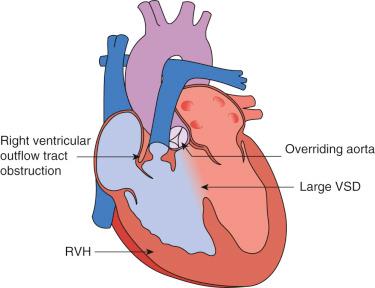
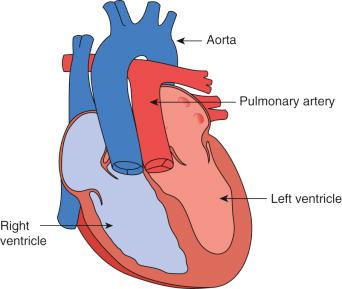
The segmental, sequential approach is the essence of diagnostic assessment in CHD. It assumes a stepwise, systematic examination of all cardiac structures or segments and their relationships (i.e., connections or alignments between segments) by navigating through the heart in the direction of blood flow. The principle of this scheme is that specific cardiac chambers and vascular structures have characteristic morphologic properties that determine their identities, rather than their positions within the body.
The approach starts by determining the cardiac position within the thorax, the direction of the cardiac apex, and the arrangement or situs of the thoracic and abdominal organs. The cardiac position can be described as the spatial location of the majority of the cardiac mass within the thorax, using the sternum as the midline reference ( Fig. 16.3 ). The cardiac orientation refers to the alignment from the base (great arteries) to the apex (ventricular apex). In most cases, the cardiac position and base-to-apex orientation are in agreement, meaning that both are aligned in the same direction. Thus, for simplicity the following terms are frequently used in clinical practice: levocardia if the heart is in the left hemithorax and the ventricular apex is directed toward the left (as is case of the normal heart); dextrocardia if the heart is located in the right hemithorax and the apex is toward the right; and mesocardia if the heart and apex are in midline position. An abnormal location of the heart within the thorax (i.e., cardiac malposition) can result from displacement by adjacent structures or underlying noncardiac malformations (e.g., diaphragmatic hernia, lung hypoplasia, scoliosis).

The visceral situs, or sidedness, of the abdominal organs (i.e., liver and stomach) and atrial situs are considered independently ( Fig. 16.4 ). Visceral situs is classified as solitus (i.e., normal arrangement of viscera, with the liver on the right, stomach on the left, and a single spleen on the left), inversus (i.e., inversion of viscera, with the liver on the left and stomach on the right), or ambiguous (i.e., indeterminate visceral position). Abnormal arrangements or sidedness of the abdominal viscera, heart, and lungs, as seen in heterotaxy syndromes, are associated with a high likelihood of complex cardiovascular disease. The atrial situs, atrioventricular (AV) connections, ventricular looping (i.e., position of the ventricles as a result of the direction of bending of the straight heart tube during early development), ventriculoarterial connections, and the relationship between the great vessels are then delineated. Additional goals of the complete morphologic evaluation in CHD include, among other aspects, interrogation of structures such as the branch pulmonary arteries, aortic arch, and coronary arteries.
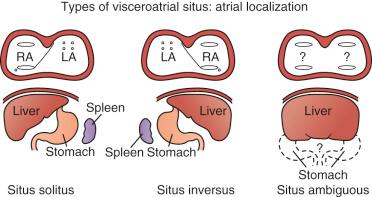
Associated malformations are described, including number, size, and location of septal defects, valvar pathology, and great vessel abnormalities. Whereas many types of congenital defects fall neatly into well-known classification schemes, others, such as those associated with heterotaxy syndromes where there is malposition of the heart and abdominal organs, are often more difficult to precisely define.
The wide spectrum of cardiovascular malformations in the pediatric age group presents a challenge to the clinician who does not specialize in the care of these children. Even for those with a focus or interest in cardiovascular disease, the range of structural defects and the varied associated hemodynamic perturbations can be overwhelming (see Chapter 23 ).
Several classification schemes have been proposed to characterize and categorize the various congenital cardiac defects, including some that categorize structural defects into simple or complex lesions, consider the presence or absence of cyanosis, or recognize whether pulmonary blood flow is increased or decreased. A physiologic classification system can facilitate understanding of the basic hemodynamic abnormalities common to a group of congenital or acquired lesions and assist in patient management ( Table 16.1 ). The following approach sorts pediatric heart disease into six broad categories according to the underlying physiology or common features of the pathologies.
| Volume Overload Lesions |
| Atrial septal defect |
| Ventricular septal defect |
| Atrioventricular septal defect |
| Patent ductus arteriosus |
| Truncus arteriosus |
| Obstruction to Systemic Blood Flow |
| Aortic stenosis |
| Coarctation of the aorta |
| Interrupted aortic arch |
| Hypoplastic left heart syndrome |
| Obstruction to Pulmonary Blood Flow |
| Pulmonary stenosis |
| Tetralogy of Fallot |
| Pulmonary atresia |
| Parallel Circulation |
| d -Transposition of the great arteries |
| Single-Ventricle Lesions |
| Tricuspid atresia |
| Double-inlet left ventricle |
| Unbalanced atrioventricular septal defect |
| Intrinsic Myocardial Disorders |
| Cardiomyopathy |
| Myocarditis |
Volume overload lesions typically are caused by left-to-right shunting at the level of the atria, ventricles, or great arteries. If the location of the shunt is proximal to the mitral valve (e.g., ASD, partial anomalous pulmonary venous return, unobstructed total anomalous pulmonary venous return), right heart dilation occurs. Lesions distal to the mitral valve (e.g., VSD, patent ductus arteriosus [PDA], truncus arteriosus) lead to left heart dilation. Children with AV septal defects, also known as AV canal or endocardial cushion defects, also fit into this category. The magnitude of the shunt and resultant pulmonary-to-systemic blood flow ratio (Q̇ pulm /Q̇ sys ) dictate the presence and severity of the symptoms and guide medical and surgical therapies. Diuretic therapy and afterload reduction are beneficial in controlling pulmonary overcirculation and ensuring adequate systemic cardiac output. Surgical interventions or transcatheter approaches may be required to address the primary pathology associated with ventricular volume overload (see Chapter 22 ).
Several lesions are associated with systemic outflow tract obstruction. Conditions characterized by ductal-dependent systemic blood flow in the neonate include critical aortic stenosis, severe aortic coarctation, aortic arch interruption, and hypoplastic left heart syndrome. Prostaglandin E 1 therapy maintains ductal patency and ensures adequate systemic blood flow until surgical or transcatheter intervention is performed in the first few days of life to relieve the systemic outflow obstruction. Inotropic and/or mechanical ventilatory support are often necessary in the affected neonate/small infant. These children frequently also have significantly increased pulmonary blood flow with a large Q̇ pulm /Q̇ sys ratio, requiring diuretic therapy and manipulation of the systemic and pulmonary vascular resistances to control blood flows.
Defects with pulmonary outflow tract obstruction include those with ductal-dependent pulmonary blood flow. Critical pulmonary valve stenosis and pulmonary atresia with intact ventricular septum, for example, are anomalies that rely on patency of the ductus arteriosus for pulmonary blood flow. Affected infants frequently require prostaglandin E 1 infusions for management of their cyanosis until the pulmonary outflow obstruction is relieved or bypassed.
In the neonate with d -transposition of the great arteries, the pulmonary and systemic circulations operate in parallel rather than in the normal configuration in series. In this condition, the right ventricle ejects deoxygenated blood into the aorta, and the left ventricle ejects oxygenated blood into the pulmonary arteries. Mixing of blood in this setting can occur at the atrial, ventricular, or ductal levels (see Fig. 16.2 ). Although prostaglandin E 1 therapy maintains ductal patency and enhances intercirculatory mixing, balloon atrial septostomy to create or enlarge an existing restrictive interatrial communication, allowing for or augmenting mixing, is necessary in some infants. Mixing at the atrial level is considered much more effective than at the ventricular or ductal levels.
This category is the most heterogeneous group, consisting of defects associated with AV valve atresia (i.e., tricuspid atresia), heterotaxy syndromes, and many others. In some cases, both atria empty into a dominant ventricular chamber (i.e., double-inlet left ventricle), and although a second rudimentary ventricle can be present, the physiology is that of a single-ventricle or univentricular heart. Other cardiac malformations with two distinct ventricles (i.e., unbalanced AV septal defect) can also be considered in the functional single-ventricle category because of associated defects that may preclude a biventricular repair. A common feature of these lesions is complete mixing of the systemic and pulmonary venous blood at the atrial or ventricular level. Another frequent finding is aortic or pulmonary outflow tract obstruction.
An important goal in single-ventricle management involves optimization of the balance between the pulmonary and systemic circulations early in life. This is a critical issue because low pulmonary vascular resistance and limitation of the ventricular volume load are prerequisites for later palliative strategies and optimal outcomes in these children. These considerations are also relevant for anesthesia management during noncardiac surgery (see Chapter 23 ). The child with single-ventricle physiology represents a high-risk group for adverse events during noncardiac surgery.
Children with primary cardiomyopathies or myocarditis have intrinsic diseases of cardiac muscle. They frequently have impaired systolic and/or diastolic ventricular function and benefit from therapies tailored to their particular disease process.
The term cardiomyopathy refers to diseases of the myocardium associated with cardiac dysfunction. They have been classified as primary and secondary forms. Primary forms are those predominantly involving the heart owing to genetic mutation, including ion channelopathies, acquired disease, or mixed. The most common types in children are hypertrophic, dilated or congestive, and restrictive cardiomyopathies. Other forms include left ventricular noncompaction and arrhythmogenic right ventricular dysplasia. Secondary forms of cardiomyopathies are those with systemic involvement in other organ systems as seen in association with neuromuscular disorders such as Duchenne muscular dystrophy, glycogen storage diseases (i.e., Pompe disease), hemochromatosis or iron overload, and mitochondrial disorders. Chemotherapeutic agents such as anthracyclines can result in dilated cardiomyopathy. It is important to understand the hemodynamic processes behind the myocardial disease and implications for acute and chronic management.
Hypertrophic cardiomyopathy (HCM) is characterized by ventricular hypertrophy without an identifiable hemodynamic cause that results in increased myocardial wall thickness. This accounts for almost 40% of cardiomyopathies in children. The condition represents a heterogeneous group of disorders, and most of the identified genetic defects exhibit autosomal dominant inheritance patterns. This is the most common cause of sudden cardiac death (SCD) in athletes. Some children with HCM have systemic outflow tract obstruction (i.e., obstructive cardiomyopathy). It is unclear whether the few with hypertrophic obstructive cardiomyopathy, previously known as idiopathic hypertrophic subaortic stenosis, are at increased risk for SCD compared with children without obstruction.
Most children with HCM present for evaluation of a heart murmur, syncope, palpitations, or chest pain. Occasionally, an abnormal electrocardiogram (ECG) leads to referral. An accurate family history is essential. An apical impulse is often prominent. Auscultation may reveal a systolic ejection outflow murmur that becomes louder with maneuvers that decrease preload or afterload (e.g., standing, Valsalva maneuver) or increased contractility. The murmur decreases in intensity with squatting and isometric hand grip. A mitral regurgitant murmur can also be present. The ECG meets criteria for left ventricular hypertrophy in most children ( Fig. 16.5 ). In some, the electrocardiographic findings can be striking ( Fig. 16.6 ). A hypertrophied, nondilated left ventricle is a diagnostic feature as determined by two-dimensional echocardiography ( ). In many children, the hypertrophy can be asymmetric ( ). Echocardiography is the preferred imaging tool for long-term assessment of ventricular wall thickness, chamber dimensions, presence and severity of obstruction, systolic and diastolic function, valve competence, and response to therapy. Other diagnostic approaches such as cardiac catheterization and magnetic resonance imaging (MRI) can add helpful information in some cases.
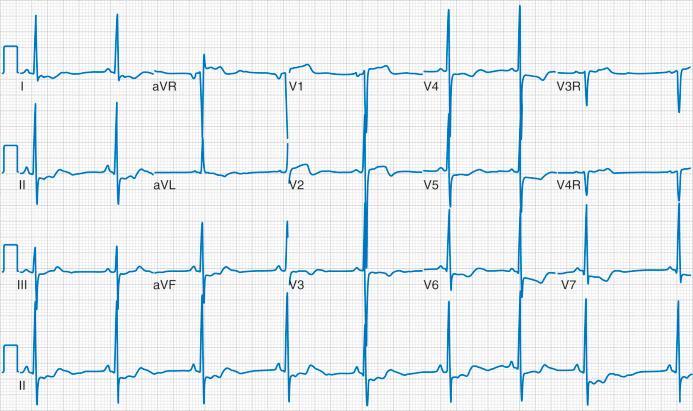
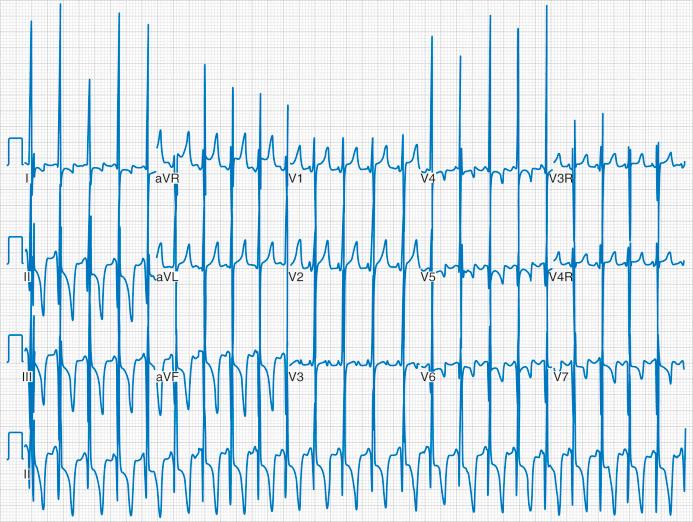
The care of children with HCM includes maintenance of adequate ventricular preload, particularly in those with dynamic obstruction. Diuretics are not indicated and can be detrimental to the hemodynamic state by reducing left ventricular volume and increasing the outflow tract obstruction. Drugs that augment myocardial contractility (e.g., inotropic agents, calcium infusions) are not well tolerated. Patients usually undergo continuous electrocardiographic monitoring (i.e., Holter recording) and exercise testing for risk stratification. β-Blockers and calcium channel blockers are the primary drugs for outpatient therapy. Therapies range widely and include longitudinal observation with medical management of heart failure and arrhythmias, implantation of cardioverter-defibrillators, surgical myotomy or myectomy, transcatheter alcohol septal ablation, and cardiac transplantation.
Dilated cardiomyopathy (DCM), also known as congestive cardiomyopathy, is characterized by thinning of the left ventricular myocardium, dilation of the ventricular cavity, and systolic functional impairment. The broad number of etiologies range from genetic or familial forms to those caused by infections, metabolic derangements, toxic exposures, and degenerative disorders. Chronic tachyarrhythmias can also lead to DCM that may or may not improve after control of the rhythm disturbance.
Most children with DCM present with signs and symptoms of congestive heart failure (e.g., tachypnea, tachycardia, gallop rhythm, diminished pulses, hepatosplenomegaly). The chest radiograph typically demonstrates cardiomegaly, pulmonary vascular congestion, and in some cases, atelectasis ( Fig. 16.7 ). The ECG can identify the likely cause of the cardiac dysfunction in those with cardiomyopathy caused by rhythm disorders or anomalous origin of the left coronary artery from the pulmonary artery (ALCAPA). The ECG can confirm the diagnosis by demonstrating a dilated left ventricle with decreased systolic function ( ). Therapy in the acute setting is supportive and aimed at stabilization. Management includes afterload reduction, inotropic support, and mechanical ventilation. Unlike children with HCM, those with DCM have a volume-loaded, poorly contractile ventricle. Gentle diuresis is beneficial. The infusion of large fluid boluses is poorly tolerated and can result in hemodynamic decompensation and cardiovascular collapse. The outcomes of children with dilated cardiomyopathy vary. For most, either the extent of cardiac dysfunction remains unchanged or recovery of left ventricular systolic function occurs, but others eventually require cardiac transplantation. A subset of children with severe disease may require mechanical circulatory support as a bridge to recovery or cardiac transplantation ( Fig. 16.8A and B ) (see Chapter 21 ).
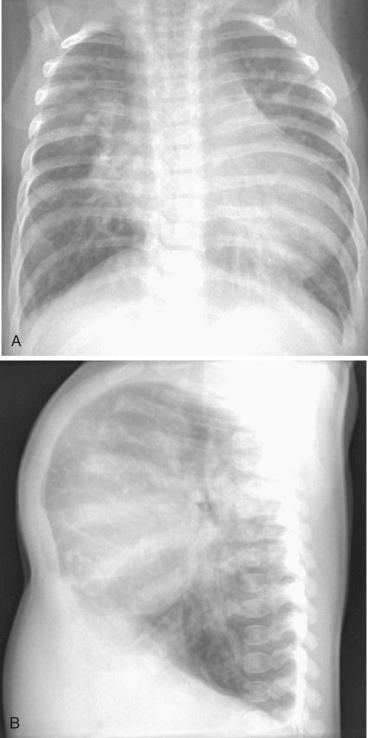
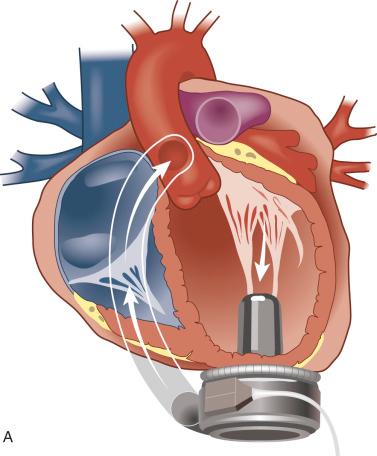
Restrictive cardiomyopathy (RCM) is the least common of the major types of cardiomyopathies (5%) and portends a poor prognosis when it manifests during childhood. The disorder is characterized by diastolic dysfunction related to a marked increase in myocardial stiffness resulting in impaired ventricular filling; most cases are thought to be idiopathic. Presenting symptoms are nonspecific and primarily respiratory. Occasionally, the diagnosis is made after a syncopal or sudden near-death event. The physical examination can demonstrate hepatosplenomegaly, peripheral edema, and ascites.
The echocardiographic hallmark of RCM is that of severe atrial dilation and normal or small-sized ventricles ( ). The marked diastolic dysfunction leads to increased end-diastolic pressures, left atrial hypertension, and secondary pulmonary hypertension. Children with RCM are prone to thromboembolic complications and anticoagulation therapy is frequently recommended. This is an important consideration during perioperative care because adjustments in the anticoagulation regimen may be necessary. Atrial and ventricular tachyarrhythmias can also occur. Optimal medical treatment is controversial because no specific agents or strategies have been shown to significantly alter outcomes. Similar to children with HCM, diuretics often cause a decrease in the needed preload with detrimental effects on hemodynamics. Inotropic agents are not indicated because systolic function is preserved and the arrhythmogenic properties of inotropic drugs can induce a terminal event. In many centers, cardiac transplantation has been effectively used.
Myocarditis is defined as inflammation of the myocardium, often associated with necrosis and myocyte degeneration. In the United States, it is most often caused by a viral infection. Over the past 20 years, the spectrum of viral pathogens causing myocarditis has changed, such that adenovirus, enteroviruses (e.g., coxsackievirus B), and parvovirus have become the most frequent causes of fulminant disease.
The overall true incidence of myocarditis is unknown because it is frequently underdiagnosed and unrecognized as a nonspecific viral syndrome. A large, 10-year, population-based study on cardiomyopathy found an annual incidence of 1.24 cases per 100,000 children younger than 10 years of age; only a fraction of cases represented those with myocarditis. The diagnosis is made using clinical history, physical examination, and imaging modalities. Myocarditis is highly suspected when a child presents with new-onset congestive heart failure or ventricular arrhythmias without evidence of structural heart disease. The ECG typically demonstrates low-voltage QRS complexes with tachycardia, which sometimes is ventricular in origin. Chest radiography often shows cardiomegaly with pulmonary vascular congestion ( Fig. 16.9 ). Echocardiography displays ventricular dilation with decreased systolic function, similar to DCM, and it is useful in the exclusion of alternative diagnoses, such as pericardial effusion or coronary artery anomalies. Myocarditis is a clinical diagnosis because definitive confirmation requires the analysis of tissue obtained through myocardial biopsy in the catheterization laboratory or the operating room (rarely performed).
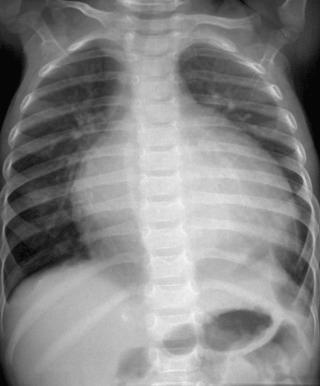
Many children with myocarditis have subclinical or mild clinical disease, whereas others progress to overt heart failure or arrhythmias, or both. Among children with heart failure, approximately one-third will regain full ventricular function, one-third will recover but continue to demonstrate impaired systolic function, and one-third will require cardiac transplantation. A subset of children, not all of whom initially manifest severe symptoms in the acute period, will progress to develop DCM.
Although no specific therapies have been identified to directly treat the myocardial injury, a variety of strategies have been used. The current paradigm includes diuresis and afterload reduction to improve myocardial performance without placing a large burden on an already failing heart. Rhythm disturbances are treated appropriately. Therapy with immune modulation or suppression with intravenous (IV) immunoglobulin is the standard of care at many centers. Mechanical circulatory support may be required in fulminant disease (see Chapter 21 ).
Acute rheumatic fever and rheumatic heart disease are leading causes of death related to acquired cardiac disease in developing countries and still occur, albeit infrequently, in developed countries. The availability of antibiotic therapy for streptococcal tonsillopharyngitis (strep throat) has markedly reduced the incidence of this disease in the United States, but sporadic cases still occur. The peak incidence in children occurs between 5 and 14 years of age.
Rheumatic fever results from infection by particular strains of group A β-hemolytic Streptococcus or Streptococcus pyogenes leading to a multisystemic inflammatory disorder. The incubation period for most strains of group A β-hemolytic Streptococcus is typically 3 to 5 days, although some children present with a more remote history of pharyngitis.
The clinical diagnosis of rheumatic fever is based on the Jones criteria. The combination of manifestations (major and minor) necessary to meet these criteria has been modified several times over the years. The most recent revision of the Jones criteria considered the contributions of echocardiography in the diagnosis of cardiac involvement. The most common manifestations of acute rheumatic fever are carditis and arthritis; thus these are considered major criteria for diagnosis. Cardiac involvement or carditis occurs in 50% of children with their first attack of rheumatic fever. Rheumatic heart disease represents a sequela of the acute process, and it most frequently affects the mitral and aortic valves. The polyarticular arthritis has a migratory pattern, typically affecting large joints.
Primary prevention of rheumatic fever and rheumatic heart disease begins with prompt recognition and appropriate treatment of the initial streptococcal infection. Penicillin is considered the treatment of choice for most patients. Secondary prevention with antibiotic prophylaxis is aimed at avoiding recurrences in individuals with a known history of rheumatic fever as they are considered at high risk. The duration of prophylaxis depends on several factors. Intramuscular injections of penicillin every 3 to 4 weeks is recommended. Current AHA guidelines no longer propose infective endocarditis (IE) prophylaxis for patients with rheumatic heart disease, except for those few instances where a prosthetic valve has been inserted or prosthetic material used in valve repair (refer to the following section). In these cases, an alternate to penicillin is used because of the potential development of drug resistance.
Elective or emergent surgery may be required in a subset of children with severe cardiac involvement. Mitral valve regurgitation is often the cause of congestive symptoms; medical management therefore has limited efficacy. Valve repair is always preferred to replacement.
CHD has become the primary risk factor for IE in children in developed countries. The risk is largely based on the nature of the cardiac condition. The infection results from deposition of bacteria or other pathogens on tissues in areas of abnormal or turbulent blood flow. The diagnosis of IE is made clinically by applying the modified Duke criteria. Major criteria include demonstration of microorganisms (two positive blood culture results) and evidence of pathologic lesions by echocardiography. The presentation of the disease can be acute or subacute. New or changing heart murmurs can indicate the development of regurgitation or obstruction on an affected valve. Physical findings of systemic embolization (i.e., minor criteria) include splinter hemorrhages (i.e., linear streaks under the nail beds), Janeway lesions (i.e., painless macules on the hands or feet), Osler nodes (i.e., small, painful nodules on the fingers), and Roth spots (i.e., retinal hemorrhages with clear centers). Inflammatory markers, such as erythrocyte sedimentation rate and C-reactive protein, are typically increased, albeit nonspecific. Microscopic hematuria, as a manifestation of renal involvement, is frequently seen.
Acute bacterial endocarditis is most commonly caused by Staphylococcus aureus. The clinical presentation includes high fevers, chills, myalgias, fatigue, and lethargy. Some children present in a critically ill state or in shock. Both left- and right-sided IE can occur in children with CHD. Children with indwelling venous catheters have an expanded spectrum of pathogens known to cause acute IE, including coagulase-negative staphylococcal species or other nonbacterial organisms.
Subacute bacterial endocarditis (SBE) often has a more indolent course and presentation. Children present with low-grade fever, malaise, anemia, and somatic complaints such as fatigue or weakness. Most frequently, one of the Viridians streptococcus group and Enterococcus species is the underlying pathogen.
Initial evaluation for bacterial endocarditis includes serial blood cultures obtained from separate sites before initiation of antimicrobial therapy. The temporal frequency of cultures depends on the clinical scenario and stability of the child. In up to 20% of children with evidence of IE, a pathogen cannot be isolated (i.e., negative-culture endocarditis), requiring empirical treatment throughout. Transthoracic echocardiography is routinely performed to evaluate for evidence of vegetations or other abnormalities. Although visualization of a vegetation establishes the diagnosis, a negative study does not exclude the diagnosis. Depending on how strongly the diagnosis is suspected, further imaging, including transesophageal echocardiography, may be necessary ( ). These imaging modalities are also valuable during follow-up.
Parenteral antibiotics are initiated after blood cultures are collected. Broad-spectrum agents are used initially, and after a pathogen has been identified, the antibiotic regimen is narrowed. Daily blood cultures are obtained until they remain sterile, confirming the adequacy of treatment. A prolonged course of antibiotics (i.e., 4–6 weeks) is required in all children. This can be facilitated by placement of a peripherally inserted central catheter (PICC). Home therapy for IE is feasible in some patients, but it depends on many factors, including clinical status, initial response to antibiotics, sensitivity of the organism to antimicrobial therapy, and the ability of infrastructure to support outpatient treatment of a serious infection (e.g., parental or family member's ability, home health care provider).
In some cases, children with IE require surgical intervention. Failure of medical therapy (i.e., inability to clear the bacteremia), abscess formation, refractory heart failure, large vegetation, and serious embolic phenomenon are indications for surgical intervention. Typically, the procedures involve resection of a vegetation, tissue debridement, or repair of consequent cardiac abnormalities. These children should subsequently receive endocarditis prophylaxis for at-risk procedures for the rest of their lives.
A high level of suspicion for IE must be maintained when evaluating a child with known heart disease and persistent bacteremia (or fungemia) or a fever of unknown origin. The same holds true for any child with foreign material in the heart or vascular tissue, such as indwelling central venous catheters, transvenous pacemakers or defibrillators, and closure devices.
The risk for developing IE from transient bacteremia is extremely small in children with normal intracardiac anatomy; however, as previously discussed, certain cardiac conditions are predisposed to acquiring endocarditis. The American Heart Association guidelines do not recommend antibiotic prophylaxis based exclusively on an increased lifetime risk of endocarditis. They propose that it should be restricted to those at greatest risk for an adverse outcome resulting from IE. Children in this category include those with specific congenital heart defects or after certain interventions, prosthetic cardiac valves, a history of IE in the past, and cardiac transplant recipients with valvular disease ( Table 16.2 ). Since the implementation of these guidelines in 2007, a review of 1157 cases of IE from 37 pediatric institutions reported no change in the incidence of this condition between 2003 and 2010, supporting the current prophylaxis guidelines.
|
|
|
|
Transient bacteremia can occur during dental procedures that involve the gingival tissues or the periapical region of teeth or perforation of the oral mucosa. Although several respiratory tract procedures are associated with transient bacteremia, no definitive data demonstrate a cause-and-effect relationship between these procedures and IE. Caution may be warranted for children at high risk undergoing invasive procedures of the respiratory tract that involve incision or biopsy of the mucosa. In contrast to previous guidelines, routine prophylactic administration of antibiotics solely to prevent IE is not recommended for those undergoing genitourinary or gastrointestinal tract procedures. However, for specific clinical scenarios, antibiotic prophylaxis may be considered. Routine endoscopy or transesophageal echocardiography does not merit routine antibiotic administration. Prophylaxis is not considered necessary for cardiac catheterization; and although many practitioners routinely administer antibiotics during transcatheter placement of devices, there is insufficient evidence to support this practice.
The guidelines recommend the administration of antibiotic prophylaxis 30 to 60 minutes before the procedure to achieve adequate tissue concentrations of antibiotics before bacteremia occurs ( Table 16.3 ). The standard prophylactic regimen for children is for oral amoxicillin. For the child who is allergic to penicillin or ampicillin, oral alternatives include cephalexin, clindamycin, azithromycin, or clarithromycin. In children who are unable to ingest oral medications, alternative antibiotics include ampicillin, cefazolin, and ceftriaxone by an IV or intramuscular route. Since IV access is obtained in the majority of children who present for elective surgery or medical procedures after induction of anesthesia, it is prudent to administer the antibiotics as soon as IV access has been established to achieve adequate tissue levels of antibiotic before skin incision or other sources of bacteremia. If the child is allergic to penicillin or ampicillin and unable to swallow oral medications, cefazolin, ceftriaxone, or clindamycin can be used.
| Situation | Antibiotic | DOSE a | |
|---|---|---|---|
| Children | Adults | ||
| Able to take oral medication | Amoxicillin | 50 mg/kg | 2 g |
| Unable to take oral medication | Ampicillin | 50 mg/kg IM or IV | 2 g IM or IV |
| or | |||
| Cefazolin or ceftriaxone | 50 mg/kg IM or IV | 1 g IM or IV | |
| Allergic to penicillins or ampicillin and able to take oral medication | Cephalexin b,c | 50 mg/kg | 2 g |
| or | |||
| Clindamycin | 20 mg/kg | 600 mg | |
| or | |||
| Azithromycin or clarithromycin | 15 mg/kg | 500 mg | |
| Allergic to penicillins or ampicillin and unable to take oral medication | Cefazolin or ceftriaxone c | 50 mg/kg IM or IV | 1 g IM or IV |
| or | |||
| Clindamycin | 20 mg/kg IM or IV | 600 mg IM or IV | |
a Single dose to be administered 30 to 60 minutes before the procedure. The total pediatric dose should not exceed the adult dose.
b Alternatively, another first- or second-generation oral cephalosporin is administered in an equivalent pediatric or adult dosage.
c Cephalosporins should not be used in an individual with a history of anaphylaxis, angioedema, or urticaria to penicillins or ampicillin.
Although there was initial hesitation to alter the practice regarding endocarditis prophylaxis for patients with CHD undergoing gastrointestinal or genitourinary procedures following the most recent guidelines, many health care providers have now adopted the updated recommendations.
Kawasaki disease (i.e., mucocutaneous lymph node syndrome) is a fairly common and potentially fatal form of systemic vasculitis of unknown origin. It is a condition seen predominantly in infants and young children. The disease can affect the coronary arteries resulting in dilation and aneurysmal formation.
The diagnosis relies on clinical features. To meet criteria, a child must have persistent fevers and at least four of the following findings :
Polymorphous exanthem
Peripheral extremity changes (e.g., erythema, desquamation, edema of the hands or feet)
Bilateral, nonexudative conjunctivitis
Cervical lymphadenopathy (often unilateral)
Oral changes (i.e., strawberry tongue; red, dry, or cracked lips)
Nonspecific findings can include irritability, hydrops of the gallbladder, sterile pyuria, arthritis, and aseptic meningitis. Acute-phase reactants and thrombocytosis are usually present.
Intravenous gamma globulin (IVIG) and high-dose aspirin are recommended during the acute phase of the disease. In some cases, additional antiinflammatory therapy is needed. The incidence of coronary artery aneurysms is significantly reduced if high-dose IVIG is administered within the first 10 days of the illness. The presence of coronary artery aneurysms is considered diagnostic for Kawasaki disease ( Fig. 16.10 ). In children with coronary artery aneurysms, low-dose aspirin therapy is administered, in some cases in combination with anticoagulants or antiplatelet drugs. Myocardial ischemia and infarction, although uncommon, are important potential complications. Anesthetic care in these children requires careful consideration regarding myocardial oxygen demand and supply; on rare occasions, coronary revascularization may be necessary.
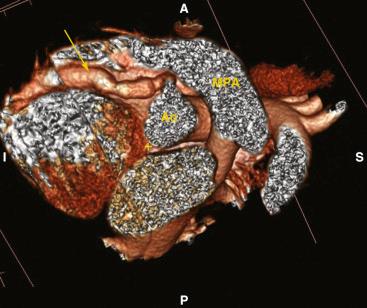
Cardiac tumors are rare in children. The natural history and optimal treatment strategies are often determined from limited case series and small studies. Atrial myxomas represent more than 90% of cardiac tumors in adults, but in children, they tend to be rhabdomyomas or fibromas. Less common types include hemangiomas, myxomas ( ), Purkinje cell tumors, and teratomas. In adults, most tumors are found in the left atrium, but cardiac tumors in children can occur in any cardiac chamber. Malignant primary tumors are rare, and data on their outcomes are limited. Other nonprimary cardiac tumors, such as neuroblastoma, can invade vascular structures and extend into the heart.
Rhabdomyomas are the most common primary cardiac tumors in children. They often involve the ventricular septum and left ventricle, and in most cases there are multiple tumors. Although they are considered benign, children can present with cardiomegaly, congestive heart failure, arrhythmias, or sudden death. The significance of a rhabdomyoma is determined largely by its size and any obstruction it may cause. Tumors of this type tend to regress over time or completely resolve; surgery is not indicated unless symptoms are present. Many children with cardiac rhabdomyomas have associated tuberous sclerosis.
Cardiac fibromas are the second most common type of pediatric primary cardiac tumors. They are typically single and involve the ventricular free wall. In a subset of fibromas, the tumor can invade the conduction system. Surgery or cardiac transplantation may be required. The tumors can be very large, and complete surgical resection can alter cardiac function.
The primary concerns in the perioperative care of children with cardiac tumors are the impact of the mass on hemodynamics and the associated abnormalities of cardiac rhythm.
Heart failure is a major field of interest and investigation in pediatric cardiology and the subject of various publications, scientific meetings, and several textbooks. The cellular basis of heart failure, compensatory mechanisms, and therapeutic strategies in children have received the most attention. The following discussion highlights key concepts as they relate to anesthetic practice.
Heart failure is considered to be a pump and circulatory failure involving neurohumoral aspects of the circulation. Several conditions may ultimately compromise the ability to generate an adequate cardiac output to meet the systemic circulatory demands. This disease state does not necessarily imply impairment of ventricular systolic function. Diastolic heart failure is an increasingly recognized clinical entity.
Pediatric heart failure results from markedly different etiologies from those reported in adults. The causes of heart failure in children vary with age. In the perinatal period, cardiac dysfunction can be related to birth asphyxia or sepsis or constitute an early presentation of CHD. The neonate with heart failure frequently presents with clinical signs of a low cardiac output state. Causes include left-sided outflow obstruction (e.g., aortic stenosis, aortic coarctation, hypoplastic left heart syndrome), severe valve regurgitation (e.g., Ebstein anomaly), or absent pulmonary valve syndrome.
During the first year of life, heart failure is predominantly caused by structural heart disease. Other causes include cardiomyopathies owing to inborn errors of metabolism or acute events such as myocarditis. In infants with heart failure, tachypnea, dyspnea, tachycardia, feeding difficulties, and failure to thrive are prominent features. The physical examination can display grunting respirations, rales, intercostal retractions, a gallop rhythm, and hepatosplenomegaly. Frequently, a mitral regurgitant murmur is present.
Beyond the first year of life, heart failure is a consequence of previous surgical interventions, unpalliated or unrepaired cardiovascular disease, cardiomyopathies, myocarditis, or anthracycline therapy for a malignancy. Occasionally, a child may present with severe ventricular systolic impairment related to ongoing myocardial ischemia as a result of a coronary artery anomaly or rarely because of acquired pathologies such as Kawasaki disease. Older children with heart failure exhibit exercise intolerance, fatigue, and growth failure, whereas adolescents have symptoms similar to those of adults ( Table 16.4 ).
| Commonly Encountered | Less Commonly Encountered | |
|---|---|---|
| Infants and young children |
|
|
| Older children and adolescents |
|
|
Therapy is tailored to the cause of the cardiac dysfunction and may include supportive care, mechanical ventilation, inotropic support, afterload reduction, prostaglandin E 1 therapy to maintain pulmonary or systemic blood flow, maneuvers to balance the systemic and pulmonary circulations, catheter-based interventions, and/or surgery. The main goal of therapy for acute heart failure is to maintain organ perfusion. Pharmacologic agents include inotropes (used on a very-short-term basis, if necessary) and inodilators. Favored agents for use in children are diuretics, including aldosterone antagonists, angiotensin-converting enzyme inhibitors, and β-blockers. Other drugs that have received attention in the management of pediatric heart failure include nesiritide (a recombinant form of human B-type natriuretic peptide) and carvedilol (a third-generation β-blocker). An overview of diagnostic strategies and available therapies for pediatric heart failure can be found in Fig. 16.11 .
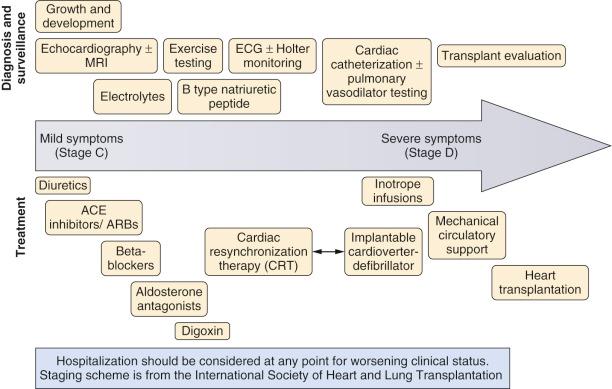
Anesthesia for children with heart failure can be quite challenging. The severity of the condition and degree of baseline decompensation can influence the likelihood of an untoward event and the potential for hemodynamic instability and a poor outcome. Several publications have addressed the risks associated with anesthesia in this setting. It is important to first reexamine the risk/benefit ratio in these patients before going forward with the planned procedure. In most surgical settings, tracheal intubation and mechanical ventilation are indicated. The need for invasive monitoring should be based on the clinical situation, anticipated nature of the procedure, and impact on hemodynamic state.
Many disorders, including those resulting from chromosomal abnormalities, single-gene defects, gene deletion syndromes, known associations (i.e., nonrandom occurrence of defects), and teratogenic exposure, can manifest as cardiovascular disease. The coexistence of frequently associated multiple organ system comorbidities with cardiovascular disease presents several challenges to the anesthesia care provider.
Trisomy 21 (Down syndrome) is the most common chromosomal anomaly, occurring with a frequency of 1 per 800 live births. The incidence increases sharply with advanced maternal age. Down syndrome results from Trisomy 21 in most children, but it may occur from a balanced or unbalanced chromosomal translocation or mosaicism. The phenotypes are indistinguishable. Affected children are typically smaller than normal for age. Craniofacial features include microbrachycephaly, short neck, oblique palpebral fissures, epicanthal folds, Brushfield spots, small and low-set ears, macroglossia, and microdontia with fused teeth. Mandibular hypoplasia and flattened facial features are common. A narrow nasopharynx with hypertrophic lymphatic tissue (e.g., tonsils, adenoids) in combination with generalized hypotonia frequently leads to obstructive sleep apnea. Other conditions include developmental delay, cervical spine disorders with vertebral and ligamentous instability (i.e., subluxation risk), thyroid disease, leukemia, obesity, subglottic stenosis, and gastrointestinal problems, particularly duodenal atresia.
The preoperative assessment of children with Down syndrome should include a comprehensive evaluation and management plan to minimize risks. The intellectual disability of these children may require the use of premedication or sedatives. Specific issues of concern include the potential for upper airway obstruction caused by a large tongue, postextubation stridor, and cervical spine injury. Vascular access can be challenging. Subjectively, children have small and abnormal radial vessels, vascular hyperreactivity, fragile tissue consistency, and an increased risk for complications after arterial cannulation.
Cardiovascular defects occur in 40% to 50% of children with Down syndrome, and it has been recommended that they all should undergo screening for CHD in early infancy. The most common lesions include AV septal defects ( ), VSDs, TOF, and PDA. Bradycardia under anesthesia occurs commonly, although the mechanism is poorly understood. Pulmonary hypertension can result from the cardiac pathology or from chronic hypoxemia caused by upper airway obstruction (i.e., obstructive sleep apnea) and should be considered in their management. Reduced nitric oxide bioavailability has been reported in patients with Down syndrome, leading to endothelial cell dysfunction and possibly explaining the observed increased pulmonary vascular reactivity.
Trisomy 18 (Edwards syndrome) is recognized as the second most common chromosomal trisomy (1 per 3500 live births). Most children exhibit microcephaly, delayed psychomotor development, and developmental delay. Characteristic craniofacial features include micrognathia or retrognathia and microstomia, which can affect airway management, as well as malformed ears, and microphthalmia. Skeletal anomalies include clenched fingers and severe growth retardation. Neurologic problems include hypotonia and central nervous system malformations. Their high mortality rate is related to cardiac and renal problems, feeding difficulties, sepsis, and apnea caused by neurologic abnormalities.
Cardiovascular disease, consisting primarily of VSDs and polyvalvular disease, is present in most children with trisomy 18. Implications for anesthesia care include the increased risk of congestive heart failure and aspiration pneumonia. These children can require interventions to address associated gastrointestinal or genitourinary anomalies.
Trisomy 13 (Patau syndrome) is an uncommon autosomal trisomy with an incidence that ranges from 1 per 5000 to 12,000 live births. Major features include cleft lip and palate, holoprosencephaly, polydactyly, rocker-bottom feet, microphthalmia, microcephaly, and severe developmental delay. Almost all children have associated cardiovascular defects, including PDA, septal defects, valve abnormalities, and dextrocardia. The overall prognosis for these children is extremely poor.
Turner syndrome is a genetic disorder characterized by partial or complete X chromosome monosomy. The estimated incidence is 1 per 5000 live-born female infants. Spontaneous miscarriages occur commonly in affected fetuses. Features of this syndrome include webbed neck, low-set ears, multiple pigmented nevi and micrognathia, lymphedema, short stature, and ovarian failure. Systemic manifestations include cardiac defects (notably aortic coarctation and bicuspid aortic valve), hypertension, hypercholesterolemia, renal anomalies, liver disease, and inflammatory bowel disease. Obesity is common in older children, together with an increased incidence of endocrine abnormalities such as hypothyroidism and diabetes.
Williams syndrome (also known as Williams-Beuren Syndrome) is a congenital disorder with an incidence of 1 per 10,000–20,000 live births. In most cases, it results from a deletion in the long arm of chromosome 7, altering the elastin gene. Features of Williams syndrome are elfin facies, hypersocial personality, endocrine abnormalities (including hypercalcemia and hypothyroidism), developmental delay, growth deficiency, and altered neurodevelopment. Structural cardiovascular abnormalities, which occur in 80% of these children, most commonly include valvar and supravalvular aortic stenosis ( Fig. 16.12 ) and aortic coarctation. The arteriopathy, manifested as stenosis, can also involve the pulmonary arteries, origins of the coronary arteries, or other vessels (e.g., aortopathy). Diffuse narrowing of the abdominal aorta can be associated with renal artery stenosis.
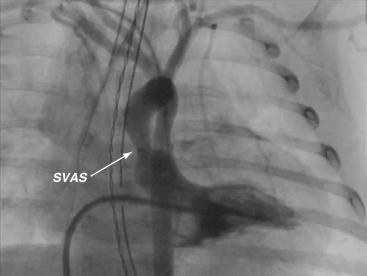
Several reports have described acute hemodynamic deterioration, cardiovascular collapse, and death during anesthesia. Two conditions can increase morbidity and the potential for anesthesia and sedation-related cardiac arrest: coronary artery abnormalities, leading to myocardial ischemia, and severe biventricular outflow tract obstruction. A comprehensive cardiac evaluation of all children is advisable because the spectrum of disease and the potential for devastating implications in affected individuals vary. Children undergoing sedation or anesthetic care occasionally require further studies and even management changes before proceeding with a planned procedure. Even asymptomatic children and those without evidence of clinical cardiovascular disease might be at risk for major morbidity and death during situations associated with hemodynamic stress. Extreme vigilance and particular attention to signs of myocardial ischemia is warranted, as is a plan of action in the event of acute decompensation. This syndrome is one of the leading causes of cardiac arrest in the Pediatric Perioperative Cardiac Arrest (POCA) registry and requires the consideration of specific management issues.
In view of these concerns and the fact that resuscitative efforts are frequently unsuccessful and refractory to aggressive efforts in children with elastin arteriopathy, the following measures have been proposed: (1) careful risk/benefit assessment of the planned procedure should be undertaken, (2) children should be cared for by personnel with expertise in this patient population and potential challenges that may be encountered, and (3) the care should be delivered at institutions with the resources to support the need for an acute intervention and an aggressive resuscitation.
Children with Williams syndrome can exhibit some degree of muscular weakness, and the cautious use of neuromuscular blocking drugs has been recommended. Associated neurodevelopmental delay, attention-deficit disorder, and autistic behavior often require a premedication. Subclinical hypothyroidism is common in these children. Renal manifestations include renovascular hypertension, reduced function, and hypercalcemia-induced nephrocalcinosis.
Become a Clinical Tree membership for Full access and enjoy Unlimited articles
If you are a member. Log in here